And it’s a joke. Seriously, I can’t describe it any other way. Look at the following districts – go to http://gis1.tlc.state.tx.us/ and look up Plan C125 – and tell me how they can possibly satisfy any rational legal argument for compactness or communities of interest. Let’s start with CD36, which forms a giant Gateway-style arch from Super Neighborhood 22 up into East Texas and down around to Orange County.
Let’s continue with CD35, which basically snakes along I-35 from the northern reaches of Travis County to the southern end of Bexar County.
Speaking of I-35, if you drive it through Travis County, you change Congressional districts no fewer than seven times.
Here’s CD21, which spreads tentacles into both Travis and Bexar from the west.
You really have to zoom in on the Bexar County portions of CD21 to fully appreciate its ridiculousness. The word “fractal” comes to mind in some places. As for Travis County, it gets split into five districts under this plan. When I said that the Republicans would put a piece of Travis into every single district if they could, I wasn’t kidding.
Here’s the GOP’s attempt to save Blake Farenthold by turning his district into one that’s more Hill Country and less Gulf Coast.
There’s some similar juju with HD34, which I guess is supposed to be the Aaron Pena Special.
For what it’s worth, CD27 becomes a fairly strong Republican district, according to 2008 election data. Here’s how it stacks up against some current GOP districts:
District Incumbent Obama % Houston % ========================================== 06 Barton 41.67 44.29 10 Mc Caul 43.81 44.14 12 Granger 42.50 43.10 21 Smith 42.51 40.48 23 Canseco 47.19 49.27 25* Doggett 42.40 43.63 27 Farenthold 40.78 46.28 31 Carter 42.61 42.47 32 Sessions 43.79 43.63 33 Open 42.64 43.90 34 Open 59.11 62.85 35* Open 60.70 61.16 36 Open 41.02 47.46
Greg makes the case that CD27 is really a “new” district, much as CD25 is – it may contain Lloyd Doggett’s house, but it’s not his district in any meaningful sense – and that Farenthold is actually in CD34, with Doggett likely to aim for CD35, where he may or may not get knocked off by a San Antonio hopeful. I’ll defer to him on that, I’m just going by the existing district numbers. Some of these Republican districts are more purple than I’d have expected, and much as is the case with State House districts, it may be that in a cycle or two a few of these guys could be imperiled. It’s harder for me to say with such bigger districts, but the possibility certainly exists. Honestly, it’s a bit hard to believe this map represents a genuine consensus among Republicans, as there’s plenty more they could have done to make most incumbents safer while warding off the more obvious VRA-related complaints. But we’ll see.
Anyway, it goes on and on, with no new minority opportunity district for the D/FW area in sight, and some examples of what seems to be clearcut retrogression – CD27 goes from a district with a 59.4 SSVR percentage to one with 37.2%. I suppose you can claim that CD34 makes up for that, but still. One hopes that means this map would be a non-starter with the Justice Department. In fact, Rep. Marc Veasey, whose alternate map I showed yesterday, issued the following statement about this map:
Last week, Rep. Veasey offered the Fair Texas Plan, a congressional map that provides electoral opportunity for the Texans who earned our state four additional congressional districts and meets the requirements of the Voting Rights Act. Today, Chairman Seliger and Chairman Solomons presented Texans with their proposed congressional map.
“This map is the very definition of an unfair and illegal congressional plan, one that was constructed behind closed doors with reckless disregard for the testimony of Texans who asked for a plan that adheres to the Voting Rights Act and preserves communities of interest,” Rep. Veasey explained. “The Seliger-Solomons Plan is a slap in the face of minority voters responsible for 90% of Texas growth in the last decade.”
An initial review of the proposed plan clearly indicates that it is retrogressive and creates only 10 effective minority opportunity districts out of 36 compared to the 11 effective districts in the current 32 member plan.
“In fact, preserving only 11 effective minority opportunity districts when the state now has four additional seats due to minority population growth would still be retrogressive, and I have no doubt that a plan that has only 10 effective minority opportunity districts runs afoul of the Voting Rights Act,” Rep. Veasey said.
Across the state, this discriminatory plan splits and packs minority communities. Nowhere is that illegal scheme more apparent than Tarrant and Dallas Counties. Veasey pointed out that once again, the Southeast Ft. Worth community he represents is separated from other areas of African American growth in Tarrant County and placed in a district that would be controlled by suburban Anglo voters. This time, the North Side Hispanic community is exiled to a Denton County district and Latino voters in Dallas-Ft. Worth are split into at least seven different districts.
“A plan that splits and packs the 2.1 million African Americans and Latinos in Dallas and Tarrant Counties to provide us only one effective voice in Congress is not just illegal, it’s wrong,” concluded Rep. Veasey.
MALDEF has a similar reaction.
A coalition of Latino groups which submitted partial state maps for congressional districts blasted the Republican plan. “The Solomons-Seliger map does not increase the number of Latino opportunity congressional districts despite the fact that 65% of the State’s growth over the past decade was comprised of Latinos,” said MALDEF’s Nina Perales. “Instead, the map gerrymanders more than nine million Latinos in Texas to make sure that we have no more electoral opportunity than we did in 1991.”
And as of Tuesday evening, the issue is now on the call with a hearing scheduled for Friday. In the meantime, another lawsuit has been filed.
Rep. Gene Green, D-Houston, expressed dissatisfaction with the proposed congressional redistricting because he said it neglects Hispanic population growth in Harris County and elsewhere in Texas.
“Personally, the map is fine with me,” said Green, whose district remains largely the same. “But the reason I’m not totally happy with the plan is because I don’t think it fairly treats Harris County — and particularly the Hispanic community in Harris County. I don’t think it recognizes the huge increase in the Hispanic population.”
Green said that he and three Democratic House members from Texas who represent large Hispanic populations – Reps. Charlie Gonzalez of San Antonio, Silvestre Reyes of El Paso and Lloyd Doggett of Austin, have filed suit in federal and state courts in Austin seeking court-ordered creation of two Hispanic congressional districts in Harris County with more than 60 percent Hispanic population.
Just something to consider here: After the 1991 redistricting, subsequent litigation led to the redrawing of several districts, for which special elections had to be held in 1996. After the 2001 redistricting and 2003 re-redistricting, subsequent litigation also led to the redrawing of several districts, for which special elections had to be held in 2006. Point being, whatever map we have in 2012 is unlikely to be the map we still have in 2020.
Anyway, take a look at this map and react as appropriate. I have 2010 electoral data here, and Greg has further analysis here and here. PoliTex, Trail Blazers, and the Trib have more.

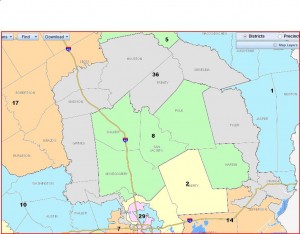
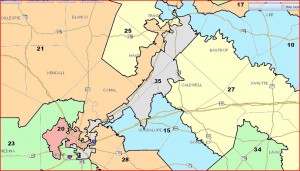
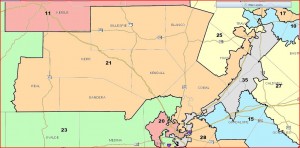
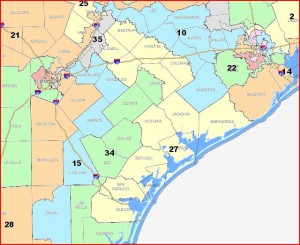
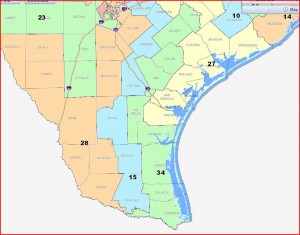
There’s some similar juju with HD34, which I guess is supposed to be the Aaron Pena Special.
I think Greg’s prediction is likely:
Yeah. Based on Peña’s residence, circa 2010, he doesn’t reside in 34. Not that it prevents him from running, but the fact that the open seat race leaves a stronger fit for either Lucio, it doesn’t look as if Aaron got his dream district for a Congressional run.
Pingback: False equivalency watch: Press outraged at perfectly reasonable Illinois redistricting | Hotspyer – Breaking News from around the web
Pingback: False equivalency watch: Press outraged at perfectly reasonable Illinois redistricting - Online Political Blog
Pingback: Daily Kos Elections Morning Digest: 6/3 | Hotspyer – Breaking News from around the web
Why the GOP continues to crack Austin is beyond me. It is over 790,000 according to the 2010 census which is higher than the average congressional district size. There is no reason for them to crack Austin in such a ridiculous manner. It would suit the Republicans well to make a single district that is completely in Austin. That way they don’t have to make these embarrassing maps.
As for DFW, where I live now. There are as many districts cracking Tarrant County as there are Travis County.
As a self-professed liberal it is not in my interest to give the GOP advice, however they are destroying their chances with the Hispanic vote by constantly splitting up the DFW minority vote. It is all too easy to pack Democrats in a Austin centric and second DFW seat, and that would help the GOP in several ways.
Pingback: Daily Kos Elections Morning Digest…6/3/11 - Politicaldog101.Com
Pingback: Senate committee approves redistricting map – Off the Kuff
Pingback: The Texas Redistricting Plan is out… and it’s bad | The American Dream Movement
Pingback: Who’s running for what where? – Off the Kuff
Pingback: Daily Kos Elections Weekend Wrap
Pingback: There may be a ‘liberal media.’ And that might be the Dems’ worst nightmare. | Hotspyer – Breaking News from around the web
Pingback: There may be a ‘liberal media.’ And that might be the Dems’ worst nightmare. | Anti American
Pingback: There may be a ‘liberal media.’ And that might be the Dems’ worst nightmare. - Online Political Blog